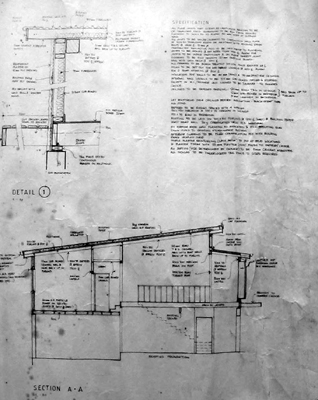Sequence viewing > Index - Alternative Photo Emulsions - Resource - ©
Lloyd Godman
Cyanotype - Historical
Context:
Cyanotypes or Blue Prints or ferro prussiate Prints
were invented by Sir John Herschel in 1842. This is one of the earliest
photographic processes, and also one of the easiest and most practical.
Blue Prints
Until recently, it had been widely used
by engineers and architects to reproduce technical drawings and was
known as blue prints. An original drawing made on tracing paper with
black ink, which might be the plans for a building, was laid, onto a
sensitized sheet, contact printed and then developed.The
blue print gained the name because the background developed blue, and
the fine lines of the plan as white lines. This enabled several plans
to be issued to various tradesmen for use with their aspect of the construction.
I remember my father making them for the installation of fire alarms.
The term Blue print became synonymous with plan, and is sometimes still
used today.

Original house plan
drawing
Mouse over to view
roll over image of Blue Print |
Suitable paper is brushed with a solution
of ammonio-citrate of iron and potassium ferricyanide. It was dried
in the dark and exposed by contact printing in daylight, which produced
a week green image. The print was then washed, which served simultaneously
to remove the coating unaffected by light and to reduce the remaining
salts, forming the image to an insoluble Prussian blue. The image is
permanent, and no chemical fixing was necessary. When white paper was
used, the image appeared bright blue on a white ground. Cyanotypes can
be toned by chemical means to various other colours, but this is often
unpredictable and sometimes affects their stability. The process itself
is very fine, the image appearing matt and slightly embedded in the
paper, as with any salt print. It has been used infrequently by photographers
to print camera images undoubtedly because of its extraordinary and
surprising colour.
A very early use of the cyanotype as a
practical means of making a permanent record was the work of Anna Atkins,
who made photograms of seaweed by this method to illustrate a privately
published book in 1843. She also produced the text by this method. There
was a later vogue for this process around the of the century, when several
photographers used it, including Frances Benjamin Johnston, Charles
Lummis, Edward Curtis, as well as many amateurs in America.
A commercial Cyanotype
kit
Want to learn more? - do a workshop or one on one with Lloyd Godman
|